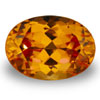C&S-Garnet_Spessartite-Genuine
Glowing with Mother Nature’s beloved orange, spice-hued Spessartite is sure to attract attention. Only recently available to designers, the stone has quickly become a favorite of jewelry buyers everywhere. A cheery, orange-hued Garnet, Spessartite was first discovered in the German Spessart Mountains. Unfortunately, so little was found that the rare gem was largely reserved for collectors. This remained so for many years, until another source was discovered along the Kunene River between Angola and Namibia. A later find in Nigeria brought a small supply to market. Supplies of gem-quality Spessartite, however, remain limited. Today this brightly colored stone, often referred to as “Mandarin Garnet,” is also mined in Sri Lanka, Pakistan, India, Israel, Brazil and Australia. Our Spessartite is mined in East Africa and is available in sizes up to eight millimeters. Larger, unique Spessartite gems are available as part of the Black Box Gemstone® collection. From the flowers of spring to summer melons, from autumn leaves to winter sunsets, orange is a color seen throughout the seasons. Boasting the same rich hues, Spessartite is a gem with year-round fashion potential. Its natural color is ideal for those who seek accessories whose beauty is unaltered.
Birthstone Information/Anniversary Stones/Gemstone Care/AGTA Codes
Quality Information & Color Information
| Quality | Description | Variations |
|---|---|---|
| A | Medium light to medium yellowish orange; slightly included; good cut |
6-4-4 |
| AA | Medium yellowish orange; very slightly included; good cut |
6-4-5 |
